Apple MacBook vs. Dell XPS 13: It's Not Even Close
The MacBook and the Dell XPS 13 are two of the most attractive ultraportable laptops you can buy, and they both command a premium. Apple's 12-incher starts at $1,299, while the XPS 13 9370 starts at $999.
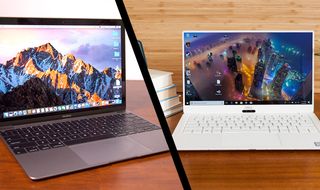
But there are a lot more differences here than there are similarities. And the MacBook is definitely starting to show its age. Based on our in-depth reviews, here's how the MacBook and and the 2018 edition of the XPS 13 stack up.
| Row 0 - Cell 0 | Apple MacBook | Dell XPS 13 9370 |
| Price | $1,299-$1,599 | $999-$2,099 |
| Colors | Rose Gold, Space Gray, Gold, Silver | Platinum Silver/Black, Rose Gold/Alpine White |
| Display | 12 inches (2304 x 1440 pixels) | 13.3 inches (1920 x 1080), 13.3-inch touch screen (3840 x 2160) |
| CPU | 7th Gen Core m3, Core i5 | 8th Gen Core i5, Core i7 |
| RAM | 8GB, 16GB | 4GB, 8GB, 16GB |
| SSD | 256GB, 512GB | 128GB, 256GB, 512GB |
| Keyboard Travel | 0.5 mm | 1.2 mm |
| Ports | USB-C, Headphone | 2 Thunderbolt 3, USB-C 3.1, microSD card, headphone, lock slot |
| Webcam | 480p | 720p |
| Size | 11 x 7.7 x 0.14-52 inches | 11.9 x 7.8 x 0.3-0.46 |
| Weight | 2.03 pounds | 2.67 pounds (non-touch), 2.68 pounds (touch) |
Design
It's hard to beat the look of Dell's InfinityEdge Display. It goes from edge to edge with nearly zero bezels, delivering a truly immersive aesthetic. The only trade-off is that the webcam is placed below the screen.
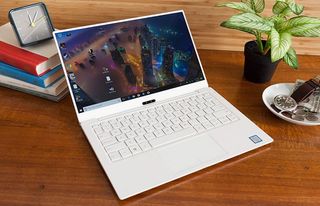
The biggest advantage Apple has in this category is portability. At 2.03 pounds, the MacBook is significantly lighter than the XPS 13's 2.68 pounds. If you opt for a touch screen, the Dell's weight increases only slightly to 2.68 pounds.
Both machines are remarkably thin, with the MacBook being the more svelte at its thinnest point (0.14 inches), and the XPS 13 being thinner at its thickest point (0.46 inches).

Apple also offers more color options than Dell does, with four hues available: Rose Gold, Space Gray, Gold and Silver. The overall aluminum unibody aesthetic, though, is getting a bit tired.
The Dell comes in just two colors -- Platinum Silver with Black on the inside and Rose Gold and Alpine White. The Alpine White on the inside is particularly striking, and is made of woven crystalline silica fiber. If you opt for black on the inside, you'll be treated to an even more comfortable soft-touch carbon-fiber material, though it's not as much of a head-turner.
Stay in the know with Laptop Mag
Get our in-depth reviews, helpful tips, great deals, and the biggest news stories delivered to your inbox.
Winner: XPS 13
Ports
Talk about minimalist. The MacBook has only a single USB-C port, which is used for charging and plugging in peripherals. That means you can't plug more than one device into this laptop unless you spring for a dongle or dock. There's also a headphone jack.
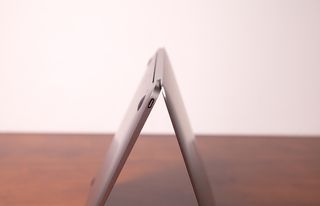
The XPS 13 comes with two Thunderbolt 3 ports, which means you can easily power two displays at the same time. The MacBook doesn't support this technology. Plus, Thunderbolt allows the Dell to connect to a growing number of graphics amplifiers, so you can boost your gaming performance.
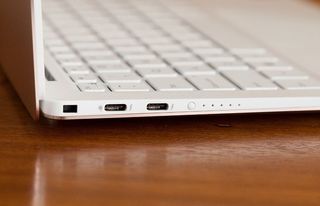
In addition, the XPS 13 sports a USB-C port, a microSD card slot, a headphone jack and a lock slot.
Winner: XPS 13
Display
The XPS 13 comes in two flavors: a full-HD (1920 x 1080) display without touch, and a 4K display (3840 x 2160) with touch. Both panels are stunning, though the 4K screen is more colorful and brighter.
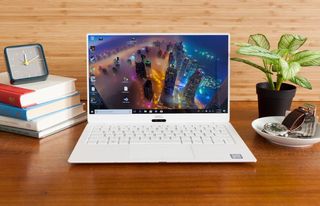
Based on our tests, the 1080p screen offers 372 nits of brightness and covers 117 percent of the color gamut. The touch-screen version of the Dell hit 415 nits of brightness and 130 percent of the color gamut.
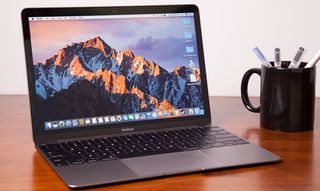
Compare those numbers to the MacBook, whose 12-inch panel registered a lower 340 nits but a solid color-gamut score of 117 percent, the same as the non-touch XPS 13.
Winner: XPS 13
Keyboard and Touchpad
The second-generation Butterfly mechanism on the MacBook is definitely an acquired taste. The key travel is only 0.5 mm, compared with 1.2 mm on the XPS 13. I've actually found that I can be faster on the MacBook's layout, but there's no arguing that the XPS 13's keyboard is more comfortable.

If you opt for the black, carbon-fiber model, the soft-touch deck on the XPS 13 adds to the comfort level. But even the crystalline silica deck on the white version of the Dell feels more comfy than the hard metal on the MacBook.
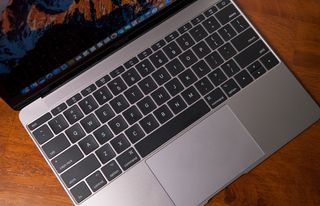
We found the touchpads on both the MacBook and the XPS 13 to be accurate. But the one on the MacBook is roomier at 4.4 x 2.7 inches, compared with 4.1 x 2.4 inches on the Dell.
Winner: XPS 13
Performance
This comparison is definitely not apples to apples. That's because we reviewed a MacBook with a low-power, 7th-generation Core m3 processor, and the XPS 13 we tested packed a high-octane, 8th-gen Core i5. The MacBook is available with a speedier Core i5 CPU, though it's still an older 7th-gen chip.
On Geekbench 4, which measures overall performance, the MacBook notched a score of 6,853. The XPS 13 nearly doubled that with a mark of 13,254.
It was no contest on the gaming front, too, as the MacBook mustered only 24 frames per second (fps) on the Dirt 3 racing title. The XPS 13 lapped Apple with 56.7 fps.
At least the SSD is speedy in the MacBook, as it turned in a data-copy rate of 467 megabytes per second, compared with 339.2 MBps in the MacBook.
Winner: XPS 13
Battery Life
The MacBook's endurance is in between that of the standard 1080p XPS 13 and the 4K model. On the Laptop Mag Battery Test, which involves continuous web surfing over Wi-Fi, the MacBook lasted 9 hours and 29 minutes. The 1080p, non-touch version of the Dell XPS 13 lasted a whopping 12 hours and 37 minutes on the same test.
However, the 4K touch-screen model of the XPS 13 lasted only 8:53.
Winner: XPS 13
Value
The MacBook starts at a steep $1,299, which is a lot to pay for a laptop with a low-power Core m3 processor. You also get 8GB of RAM and a 256GB SSD for that price. The $1,599 model steps that up to a Core i5 chip and a 512GB SSD.
Dell's XPS 13 starts at $999 for a Core i5 processor, 4GB of RAM and just a 128GB SSD. The better value is the $1,199 model, which includes the same CPU but 8GB of RAM and a 256GB SSD.
If you want a Core i7 CPU, you're looking at $1,399, and a model with a 4K touch screen starts at a rich $2,099. However, that also includes 16GB of RAM and a 512GB SSD.
Overall Winner
Sleeker, faster, longer-lasting. More ports. The XPS 13 beats the MacBook in every single category, giving Dell a dominating victory in this face-off.
| Row 0 - Cell 0 | Apple MacBook | Dell XPS 13 9370 |
| Design | Row 1 - Cell 1 | Row 1 - Cell 2 |
| Ports | Row 2 - Cell 1 | Row 2 - Cell 2 |
| Display | Row 3 - Cell 1 | Row 3 - Cell 2 |
| Keyboard/Touchpad | Row 4 - Cell 1 | Row 4 - Cell 2 |
| Performance | Row 5 - Cell 1 | Row 5 - Cell 2 |
| Battery Life | Row 6 - Cell 1 | Row 6 - Cell 2 |
| Value | Row 7 - Cell 1 | Row 7 - Cell 2 |
If you really hate Windows, the MacBook is definitely worth a look, and it's also lighter. But overall, this contest shows that Apple really needs to up its game for the 2018 MacBook.

